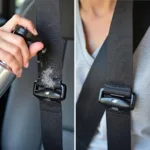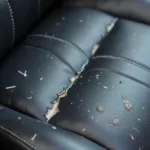Discovering a cigarette burn hole in your car seat can be frustrating. It instantly diminishes the aesthetics and potentially affects the car’s resale value. But fret not! This comprehensive guide provides a detailed walkthrough on how to repair cigarette burn holes in car seats, helping you restore your car’s interior to its former glory.
Assessing the Damage: Is DIY Repair Possible?
Before diving into the repair process, it’s crucial to assess the severity of the burn. Minor burns often involve only the fabric’s surface and are highly mendable using DIY techniques. However, if the burn penetrates through the fabric, reaching the seat’s padding or underlying structure, seeking professional help is recommended.
Materials You’ll Need for DIY Repair
Gather the following materials to effectively repair a cigarette burn hole in your car seat:
- Sharp razor blade or utility knife
- Tweezers
- Upholstery filler compound (matching your seat’s color)
- Fabric adhesive
- Matching fabric patch (optional)
- Sandpaper (fine-grit)
- Leather repair kit (for leather seats)
- Clean cloth
Step-by-Step Guide to Repairing Cigarette Burn Hole
Follow these steps to repair the cigarette burn hole in your car seat:
- Clean the area: Begin by thoroughly cleaning the area around the burn hole. Use a vacuum cleaner to remove loose debris and a damp cloth with mild soap to gently clean the fabric. Allow the area to dry completely before proceeding.
- Remove burnt fibers: Gently scrape away any loose, charred fabric fibers using a razor blade or the edge of a utility knife. Hold the blade at a shallow angle and scrape gently to avoid damaging the surrounding fabric. Use tweezers to remove any stubborn, burnt fibers.
- Apply upholstery filler: Once the area is clean and free of loose fibers, carefully apply a small amount of upholstery filler compound to the hole. Use a putty knife or your finger to spread the filler evenly, ensuring it fills the hole completely and slightly overlaps the surrounding area. Let the filler dry completely as per the manufacturer’s instructions.
- Sand and smooth: After the filler dries, use fine-grit sandpaper to smooth out the repaired area. Sand lightly and evenly, blending the filler seamlessly with the surrounding fabric.
- Apply a fabric patch (optional): For larger holes or if you want added durability, consider applying a matching fabric patch. Cut the patch slightly larger than the repaired area and secure it using fabric adhesive. Ensure the adhesive is compatible with your car’s upholstery.
- Final touch-ups: Once the adhesive dries, inspect the repaired area and make any necessary touch-ups. You can use a permanent marker or fabric paint to blend the repair seamlessly with the surrounding fabric.
Seeking Professional Help: When DIY is Not Enough
While minor cigarette burns can be tackled with DIY methods, more severe damage might require professional intervention. If the burn has significantly damaged the seat’s padding or structural components, seeking professional help ensures a seamless and long-lasting repair. Professional upholsterers have the expertise, tools, and materials to address complex repairs, including replacing damaged padding, stitching torn fabric, and matching the repaired area to the existing upholstery flawlessly.
Preventing Future Mishaps: Tips for a Burn-Free Car
- Implement a “no-smoking” policy: The most effective way to prevent cigarette burns is to establish and enforce a strict no-smoking policy inside your car.
- Use ashtrays: If smoking is unavoidable, ensure the car is equipped with functional and easily accessible ashtrays. Remind passengers to use them diligently.
- Exercise caution: Remind passengers to exercise caution when handling lighters or cigarettes, especially in moving vehicles.
By following these preventive measures, you can significantly minimize the risk of encountering these unsightly blemishes in your car’s interior.
FAQs
Q: Can I use super glue instead of fabric adhesive to secure the patch?
A: While super glue might seem like a quick fix, it’s not recommended for car upholstery repairs. Super glue can create a stiff, inflexible bond that may crack or peel over time, especially with the constant movement and pressure on car seats.
Q: Can I repair a cigarette burn hole in leather car seats using the same methods?
A: Leather repair requires specific techniques and materials. Instead of upholstery filler, you’ll need a leather repair kit that includes leather filler, color matching compounds, and specialized tools for a seamless finish. Refer to our guide on “How to Repair Rips in Leather Car Seats” for a detailed walkthrough.
Q: How much does it cost to professionally repair a cigarette burn hole in a car seat?
A: The cost varies depending on the severity of the damage, type of car seat, and location. Minor repairs might cost around [Check average repair cost in your area], while more extensive damage could range from [Provide an estimated price range]. It’s best to contact local upholstery shops for accurate quotes.
Need More Help?
For more insights on car seat repairs, check out:
- Can I Repair Cigarette Burn Hole in Car Seat?
- How Much to Repair Cloth Car Seat
- Repair Car Seat
- Car Cloth Seat Repairs Torquay Newton Abbot Area
If you’re still unsure about tackling the repair yourself, don’t hesitate to reach out to our team of car care experts via WhatsApp: +1(641)206-8880 or Email: [email protected]. We’re available 24/7 to provide guidance and support for all your car maintenance needs.



